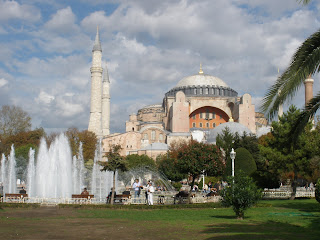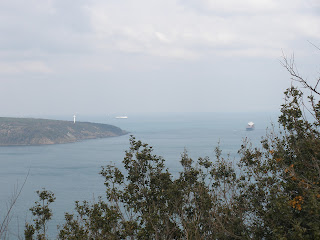The Aya Sofia or Hagia Sophia is one of the archaeological treasures of Istanbul, built in the 6th century by Byzantine Emperor Justinian in his capital, Constantinople. The building was used as a church from 537 - 1453, converted to a mosque and used in that capacity until 1931, before being established as a museum.
Hagia Sophia is located in Sultan Ahmet section of Istanbul and it a must see on all tourist itineraries as well as many local school groups.
The currrent building is believed to be the third Byzantine church constructed on this site. A frieze of lambs is thought to be from the second building, built in 415, and destroyed by fire.
The entrance hall arched ceiling is covered with exquisite mosaics.
The dome was the largest built at that time and for the next 1000 years. Not until St. Peter's in Rome, was a larger dome built. The dome is 56 meters in height or about 20 stories. This Byzantine dome had major influence in Ottoman mosque architecture as well as modern day mosque architecture.
In each of the four corners supporting the dome, is a seraphim - a six winged angel charged with caretaking of God's throne. During the time period the building was used as a mosque, the faces of the seraphim were covered. Archeaologists have now uncovered the face of one of the seraphim and it is very sweet.
The walls of Hagia Sohpia are covered in rare marbles from the region. Marble was cut into two or four pieces and opened, like a book to display symmetric designs.
The volume of space in the building is as awesome today as it was to Emperor Justinian, when he first saw it.
During the Byzantine time period mosaics were added to the walls in all the subsequent centuries. Empress Zoe established a mosaic of herself, ...
and her husband on either side of Jesus. Pictured is Zoe's third husband, Constantine IX, who was on the throne from 1042 - 1055. As the title of Emperor came through her line, her previous husbands were Emperors and were depicted in the mosaic in earlier years. It is difficult to see, but Zoe is holding a scroll with Constantine's name, which being longer than the first two husbands, did not fit well and a few characters dropped to a second line.
Hagia Sophia always has some restoration work in progress with associated scaffolding.
Bronze doors, dated to the 2nd century B.C., brought to Hagia Sophia in the 9th century by Emperor Theophilos were originally from a pagan temple in Tarsus.
If you are interested in reading more about the Byzantine time period, Judith Herrin has an excellent book, titled "Byzantium" with a chapter dedicated to The Church of Hagia Sophia.






































